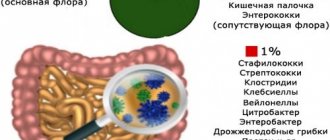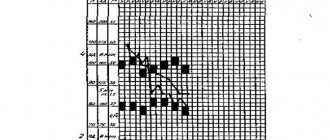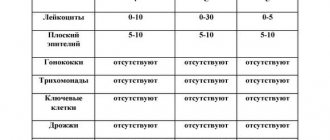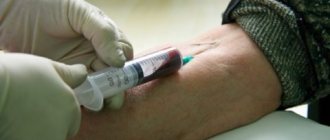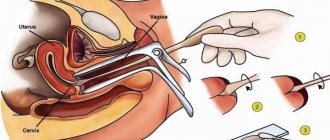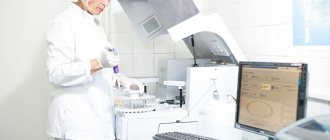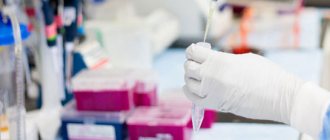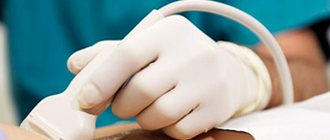PCR analysis for enterobiasis
Polymerase chain reaction is one of the most informative laboratory diagnostic methods.
The examination is always accurate, but expensive. To conduct a PCR analysis, the patient's venous blood is taken. To increase the structure of the obtained helminth DNA, special enzymes are used. After this, DNA samples of previously studied helminths and those parasites that were found in the patient’s blood are compared. This method is very accurate and sensitive. With its help, you can accurately determine the type of helminth and the degree of infestation. The approximate amount of these parasites in the body is also determined. After this examination, the doctor can talk about the prognosis of the course of the disease in each specific case.
All tests that need to be taken to determine enterobiasis may indicate other diseases. Therefore, they are not always informative. Therefore, all diseases caused by parasites require repeated tests and more thorough diagnosis.
How to find out the results of a smear test for coronavirus
When taking a swab test for the SARS-CoV-2 coronavirus, you need to immediately clarify when you can get information and how to find out about the result of the PCR test. If the examination was carried out at the direction of the clinic doctor, then he also receives the results of the examination. Usually the patient is sent a form with a response by e-mail; in the absence of an e-mail, it is possible to inform the patient by telephone.
All private clinics notify you of the results of smear tests using this method. During the period of mass examination, the time from taking biomaterial to obtaining a conclusion may be longer than usual.
What to do if the test for enterobiasis is positive
Enterobiasis is characterized by expressive symptoms. It is based on periodic itching in mild forms of the disease, which becomes permanent if the worm population has reached significant proportions.
Itching, restlessness of the child at night, possible symptoms of impaired digestion will help you mentally prepare for a positive result of the study.
Enterobiasis is highly treatable, so this outcome is not a reason to panic.
If the disease is detected in a single member of a family or any social group, then only that person needs to be treated. If pinworms are detected in two or more members of a family (group), or if the disease relapses, treatment is prescribed to each member. The drugs of choice are Pirantel, Albendazole, Mebendazole, Vermox and others.
Simultaneously with treatment, a number of important requirements must be met to prevent re-infection:
- wash all bedding, clothing, soft toys and other textiles that may contain pinworm eggs;
- carry out wet cleaning of all surfaces in the house that may have been touched by infected people, including upholstered furniture;
- ensure that the fingernails of all family members are cut short;
- Wash your hands thoroughly at least after every visit to the toilet and before eating.
In most cases, these simple steps are enough to prevent the disease from returning.
Video from Dr. Komarovsky about enterobiasis:
What is papillomavirus?
Human papillomavirus is a serious infectious disease that is sexually transmitted. It is dangerous because it causes various diseases and inflammations. New growths also appear on the body - papillomas. For women, in some cases, this virus can be destructive - there is a high risk of malignant tumors in the uterine cavity due to infection. Papilloma can easily develop into carcinoma.
Don't panic if you see a positive result for the virus. After all, infection and manifestation of the disease are different concepts. Usually, within a year, the body independently fights the disease, forming immunity. True, timely diagnosis will not hurt. After all, then you will be able to choose treatment if necessary.
Mechanism of infection
Do not think that only those people who live in unsanitary conditions and do not adhere to the rules of personal hygiene are exposed to infection. It is easy for even a very neat and clean person to become infected with enterobiasis.
The disease is transmitted from a sick person to a healthy person. The first of them, without meaning to, “scatters” pinworm eggs onto all the objects he uses or touches. Failure to wash the hands of a healthy person in a timely manner and the consequence of this is a swallowed helminth egg.
Pinworm eggs cannot live in the stomach, so they move to the small intestine. During its progress, the egg matures. By the time the larva (egg) reaches the large intestine, it will become a mature individual. Fertilization of the female occurs in the colon.
Parasites reproduce only outside the rectum, mainly at night. It is at night, when a person relaxes, in particular the anal sphincters relax, that it is easiest for pinworms to come out. Crawling out from the rectum, the female lays an average of 11,000 eggs in a fold near the anus and “seals” them with isovaleric acid. From this moment on, symptoms of enterobiasis begin to appear.
What is enterobiasis
The occurrence of enterobiasis is provoked by pinworms. These parasitic worms reach a size of no more than 10 millimeters. It is the pointed tip that gives pinworms their name. Parasites are observed in different colors: from white and yellow to black and dark brown. This disease is also called “dirty hands disease.”
An infected child or adult may find the night of laying particularly uncomfortable. In the morning, a person feels severe itching, which provokes him to scratch the anus. Thus, repeated self-infection most often occurs in children who have the habit of biting their nails or licking their fingers.
The pathogenesis of enterobiasis is as follows:
- pinworm eggs enter the human body through the respiratory tract or mouth;
- after about two weeks, the larvae transform into adults capable of reproduction in the intestines;
- parasites are localized in the areas of the small and large intestines;
- At night, female worms emerge from the anus to lay eggs. When laying, parasites secrete a liquid that causes itching, irritation and redness of the skin;
- After laying eggs, female pinworms die.
How to get tested for enterobiasis
Pinworms cause particular inconvenience during the process of oviposition. To crawl out, they use the baby's sleep time, when the anal muscles are not so tense. The substance secreted by the worms at these moments causes severe itching, which children cannot tolerate and begin to scratch the area of discomfort. They wake up, are capricious, and sometimes complain of stomach pain. The morning after such a restless night is the best time to take a scraping or smear for enterobiasis.
You must contact the clinic for a referral for testing. There, the health care professional will talk about possible ways to carry out the scraping procedure. There is no need to wash the child before taking a smear.
There are several options for how to test for enterobiasis.
1. The least effective is a direct stool sample. Material collection takes place at home. Prepare a clean container in advance. For analysis, take approximately 10 g of feces, without urine impurities. To make the result as reliable as possible, the study should be carried out no later than 5 hours after defecation. The analysis will be ready the next day and is valid for 10 days.
2. Scraping with a cotton swab. This method is usually used to test children for enterobiasis during hospitalization. The child is laid on his side, the nurse spreads the buttocks and wipes the folds of skin around the anus with a cotton swab dipped in glycerin. The procedure is painless and does not cause discomfort. The swab is carefully placed in a test tube and sealed. Using the same principle, a cotton swab dipped in warm water or saline can be used at home. The processing time for the analysis is 1 business day, and it is valid for 10 days.
Note!
3. Scraping using adhesive tape gives the best results. This analysis is taken from children at home, as well as in a clinic to obtain a certificate. Spread the child’s buttocks, and apply adhesive tape up to 5 cm long to the anus area. Gently press it with your finger for a few seconds, then remove the finished scraping.
Now the tape must be firmly glued onto a glass slide taken from the laboratory. To obtain a reliable result, scrapings collected using this method must be analyzed within two hours. After this time, the information content of the smear will be lost. The answer to the question of how many days a scraping for enterobiasis is valid is similar to the previous points and is 10 days.
Frequency of smear
If enterobiasis is diagnosed, scrapings for worm eggs should be taken repeatedly. Since deworming drugs act exclusively on adults, after several days in the intestines of children, the next generation of pinworms is formed from the surviving larvae. If a child has symptoms of enterobiasis, it is recommended to take scrapings three times, with an interval of 2 days. If the diagnosis is confirmed and pinworm eggs are detected, it is necessary to carry out treatment and repeat the smear a week later.
Collecting material for enterobiasis using adhesive tape
Using sticky plastic film to obtain diagnostic material is the best method for quickly detecting parasite eggs. The essence of this method is that a piece of sticky polyethylene film is applied to the area of the perianal folds and transferred to a glass slide for microscopy.
Another method of taking a fingerprint is used (B. E. Rabinovich’s method). An impression from the skin folds of the perianal area is made using eye blades that have a sticky surface.
Rice. 9. The photo shows a wooden spatula, a cotton swab and adhesive tape with a glass slide. All this is used to obtain material for research on enterobiasis.
How to take tests correctly
In order to identify such an unpleasant disease and carry out subsequent effective treatment, you need to consult a specialist. But many ordinary people do not know what an enterobiasis test is, how to take it, and where to go in general
Therefore, it is important to remember that to diagnose this disease you need to get a referral from a pediatrician and go with him to the laboratory of the clinic
It is also worth knowing the fact that it is necessary to take the test in the morning, before hygiene procedures are performed. This means that there is no need to wash the child before collecting material. Then the diagnosis will be as accurate as possible. As for the process of collecting material itself, it is done using adhesive tape. This method eliminates noticeable discomfort.
Cost of the procedure
In a regular clinic, testing for enterobiasis is done for everyone free of charge. Its cost is included in the medical insurance policy.
In paid institutions or private laboratories, analysis can cost from 300 to 350 rubles.
Never give children antihistamines for preventive purposes without a doctor's prescription.
They have many side effects. If you suspect that your child has pinworms, take a referral for a smear.
After the results are obtained, the doctor will decide on the need for therapy.
Treatment of enterobiasis
Treatment of enterobiasis should be comprehensive and complete, including measures to prevent possible reinvasion, implying compliance not only by the infected person, but also by contact persons with an individual hygienic regime.
Before prescribing drug treatment for an infested person, it is necessary to examine all contact people in the outbreak, since in the event of the spread of enterobiasis, all of the above persons are subject to simultaneous drug deworming. The main recommendations for maintaining a sanitary and hygienic regime in family homes come down to regular washing procedures, systematic trimming of nails, daily change of underwear, and mandatory regular washing of the perianal area with soap at least twice a day.
To carry out mechanical liberation of the body from adult helminths before and after drug treatment, soda cleansing enemas should be used.
In addition to the above non-drug measures, lubricating the perianal area with Vaseline ointment in the evening before bed is effective, which helps prevent the movement of female pinworms and their crawling into the vagina in women and girls. Non-drug methods of treating enterobiasis have the right to exist, and at the same time, the only effective method of treating this pathology remains drug therapy using special anthelmintic drugs.
The most popular drugs for use in anthelmintic therapy are Pyrantel (calculated dose is 10 mg per kg of patient weight), Vermox (100 mg once orally), Piperazine (1.5 g daily for one week), Medamin ( the calculated daily dose is 10 mg per kg of patient weight), Vormil (daily dose is 400 mg in a course of three days).
Rules for donating blood for HPV
Now it’s clear how to answer the question: test for papilloma (HPV) - what is it? We also found out how biological material is taken. But this is only one of the methods. What rules should you remember when donating blood for papilloma? Firstly, this is done on an empty stomach in the morning. You can't drink or eat - the likelihood of errors greatly increases. Secondly, in about 3-4 days, eliminate allergenic foods from your diet. Thirdly, it is advisable to take a blood test from a vein early in the morning. This way you won't feel hungry yet. You can take a chocolate bar and some drink with you. They can be taken immediately after the procedure.
Enterobiasis in adults
Enterobiasis pathogens are the most common helminths in the population that infect the human intestines. Infection of adults occurs, as a rule, through contact and household contact, mainly from infected children. The carriers of enterobiasis in adults are persons infected with pinworms. In addition to contact infection, it is possible that pinworm eggs may come into contact with food containing insects.
The female pinworm enters orally through contaminated hands and then moves through the human intestine, after which a single pathogenesis of enterobiasis develops, characteristic of people of different ages. Self-infection of an adult with enterobiasis occurs as a result of the accumulation of helminth eggs under overgrown nails. It is not always possible to completely get rid of enterobiasis from the first use of medications, especially in families with children attending organized groups.
In the case of enterobiasis in an adult, when there is not massive intestinal invasion, an asymptomatic course of the disease is most often observed, especially with the regular use of hygiene measures in the form of toileting the genital organs and perianal area. In the situation of untimely drug treatment of enterobiasis in an adult, the growth of colonies of the pathogen is noted, which helps in the development of painful itching in the anus.
Frequent scratching of the affected area causes the formation of microcracks, scratches, abrasions, which are a favorable background for the penetration of pathogenic microorganisms that provoke the development of nonspecific dermatitis, complicating the course of the underlying disease.
Long-term infestation of pinworms in adults can provoke the development of severe intestinal disorders in the form of chronic constipation or diarrhea, accompanied by the formation of intestinal dysbiosis.
Chronic enterobiasis is accompanied by prolonged intoxication syndrome, asthenia of the body, fatigue and general sensitization. Indirect laboratory markers of enterobiasis in adults are a decrease in hemoglobin levels, as well as an increase in eosinophils in the blood, which is clinically manifested by headache, dizziness, fatigue, and disturbed night sleep. Enterobiasis in women can provoke the development of endometritis and vulvovaginitis.
Coproscopy in relation to the diagnosis of enterobiasis, as a rule, is not used, since the laying of eggs by female helminths is carried out not in the intestines, but in the perianal region. Considering this feature of the helminth, for laboratory verification of the diagnosis, preference should be given to scraping for enterobiasis, for which either adhesive tape or a cotton swab lubricated with Vaseline is used. It should be taken into account that, despite the high information content of these methods for diagnosing enterobiasis, in 20% of cases false results may be observed, which is the basis for scraping three times.
When the diagnosis of enterobiasis is confirmed in an adult, it is necessary to use medicinal treatment methods as soon as possible using the same drugs as in children. If an adult patient has resistance to the therapy used, the drug Nemozol should be used, which, in addition to high pharmacological activity, is accompanied by the development of a wide range of adverse reactions.
After using any anthelmintic drug for enterobiasis, it is preferable to use a laxative, the action of which will speed up the process of freeing the body from helminths and their eggs. In contrast to the tactics of treating enterobiasis in pediatric practice, in relation to drug therapy for adults, it is mandatory to take an anthelmintic drug twice with a break of 14 days. This feature is due to the fact that the initial dose of the drug can kill only adult helminths, but it is not able to have an effect on the eggs and larvae of pinworms.
Severe itching in the perianal area can be easily relieved by taking antihistamines such as Eden or Zodak. Soda enemas are widely used as a local treatment for enterobiasis in adults. To prepare the solution, you need to dissolve 10 mg of soda in one liter of warm, clean water.
Algorithm for manipulating scrapings for enterobiasis
In the article we will tell you what methods and scraping algorithms exist for enterobiasis, what are their advantages and disadvantages.
Scraping for enterobiasis: methods
Taking a scraping for enterobiasis is the main method of obtaining biomaterial for microscopic examination as part of laboratory diagnostics.
Coprological examination of material rarely detects pinworm eggs, so detection of eggs in washings and scrapings from perianal folds is used as a more informative diagnostic method. To determine the contamination of the environment, washes are carried out from the surface of objects.
Taking a smear for enterobiasis is carried out using cellulose paper or tape, a wooden spatula or eye sticks with an adhesive layer.
Let us consider in more detail the scraping technique, the procedure for preparing for the procedure and the further sending of the biomaterial to the laboratory.
SOP “Rules for interaction of clinic staff with the diagnostic laboratory” in the journal Chief Nurse
Scraping with a wooden spatula
Taking a scraping for enterobiasis using a wooden spatula is carried out according to the following algorithm:
- a wooden stick or match is moistened in a 0.5% solution of baking soda or a 1% solution of glycerin;
- the healthcare worker carefully scrapes samples of material from the surface of the perianal folds along the entire circumference of the anus;
- a drop of 50% glycerol solution is applied to a glass slide;
- The resulting samples are transferred onto a glass slide using the edge of a cover glass, covered with it, and examined under a microscope.
The main drawback of this scraping algorithm for enterobiasis is that eggs are not detected sufficiently, and a wooden spatula has an irritating effect on the skin.
Torgushin method
Since enterobiasis is often detected in children of school and preschool age, taking scrapings for enterobiasis in children, the algorithm should be selected so as to minimize the irritating effect during the manipulation.
The Torgushin method is suitable for this:
- a spatula or stick is moistened in a glycerin solution;
- using the flushing method, the material is collected with a cotton swab;
- A smear is prepared in a drop of glycerin on a glass slide.
Kevorkova method
Taking scrapings for enterobiasis in children, Kevorkova’s algorithm is as follows:
- about 5 ml of boiled water is poured into a centrifuge tube;
- then a stick or spatula with a cotton swab is placed there;
- before taking a scraping, press the swab against the wall of the test tube and wipe the preanal folds with it;
- a spatula with a tampon is placed in a test tube;
- The swab in the test tube is shaken, the centrifuge is started for 3 minutes;
- The resulting sediment is microscopically examined.
Graham method
Proper preparation for the procedure and adherence to the material collection algorithm make this method effective in 93% of cases.
This method is a print on polyethylene tape with an adhesive layer. Algorithm:
- the imprint is taken in the morning before the toilet in the perianal area;
- A three-time study is recommended with an interval of 7-10 days;
- for the procedure you will need surgical film LPO-1, LPO-2 or transparent polyethylene tape with an adhesive layer for others up to 10 centimeters;
- the sticky layer of tape is glued to the perianal folds of the skin, without letting go of its ends;
- then the film is glued onto a glass slide, and its ends extending beyond the edge of the glass are cut off;
- the glasses are numbered and sent to the laboratory;
- in the laboratory, one edge of the film is peeled off and 1-2 drops of glycerin or petroleum jelly are applied under it and the contents are examined under a microscope.
Decoding the results
A conclusion about the examination of the scraping is issued a day later. It can be positive or negative. If the result is positive, pinworms are found in the intestines and, depending on the severity of the parasite infestation, there are three degrees of pinworm infection:
- Weak. It is indicated when single helminth eggs are detected and is designated “+” in the certificate.
- Average. When several dozen pinworm eggs are detected. The certificate is marked with “++”.
- High. If a large number of worm larvae and eggs are detected, Fr.
In this situation, it is necessary to check for the presence of helminths in surrounding people and close relatives who are in contact with an infected patient.
This is especially important when the child attends kindergarten or school
If the result is negative, this indicates the absence of helminths in the intestines or that the collection of material was done in violation of the procedure. When collecting, a large number of factors should be taken into account, including the fact that the female pinworm has not yet laid eggs on the skin.
Children are recommended to be tested at least 3 times at weekly intervals. In this case, the reliability of the research is about 90%. Taking tests once gives results with 50% confidence. If there are no symptoms of infection, then a negative assessment is correct.
The test may show a negative result, but if symptoms of infection are present, the attending physician will usually recommend several more times, after which he will prescribe treatment or preventive measures. However, some parents, in order to avoid having to undergo tests several times, on their own initiative give their children antihelminthic drugs for preventive purposes. This is strictly forbidden, since not all antihistamines can be used in the treatment of children due to strong toxic effects on the body. The decision to prescribe any drugs for the treatment or prevention of helminthic infestation should be made only by a qualified doctor.
Sometimes patients resort to the PCR diagnostic procedure. This method makes it possible to determine the presence of parasites with a 100% guarantee, but it is not popular due to its high cost.
Confirmation of enterobiasis allows you to begin treatment, which consists of following a special diet and using anthelmintic drugs. The course of therapy is prescribed by the doctor due to the characteristics of the body, the child’s age and body weight.
Analysis validity period
We should also not forget that the validity period of the scraping, or rather its results, should not exceed 10 days from the date of delivery. Otherwise, a certificate of absence of enterobiasis with a test date of more than ten days for presentation to kindergartens, schools or sports institutions will be invalid.
How many times is the test repeated?
The first laboratory test is carried out after hospitalization of a patient with suspected coronavirus infection. It manifests mainly with symptoms reminiscent of the flu - aching joints and temperature fluctuations above subfebrile values. As well as other signs of general intoxication of the body:
What is a runny nose like with coronavirus?
- increased sweating;
- dry, severe paroxysmal cough, which worsens when lying down;
- increasing weakness;
- rapid heartbeat, heart rhythm disorder;
- the victim accepting a forced position - sitting with his legs dangling;
- anxiety due to a lack of understanding of what is happening;
- feeling of lack of air when inhaling, severe shortness of breath;
- blueness of the legs and arms due to the outflow of blood;
- fainting, loss of consciousness.
But a single collection of biomaterial is not enough. When examining it, other types of pathogens may be identified, rather than coronaviruses already spreading through the respiratory tract. This may be due to the insufficient sensitivity of the test systems used or the still weak activity of the pathogens of coronavirus infection. When a person has characteristic signs of respiratory pathology, tests need to be done three times. In other cases, two biochemical studies are usually sufficient.
The collection of material for laboratory testing for the presence of coronavirus infection is carried out by medical workers of the hospital where the patient is hospitalized, with mandatory compliance with safety requirements when working with pathogens of the second hazard group.
Preventive measures
If you follow the treatment recommendations described above, a favorable result will be achieved. Scraping for enterobiasis should be done regularly after the first case of infection. And to keep it always “clean” in the future, you should focus on prevention. Such measures are extremely important, since they can help prevent re-infection and, as a result, a new cycle of treatment.
Here are simple hygiene rules to pay attention to in case of infection:
- carry out wet cleaning of the premises every day;
- trim your nails in a timely manner so that pinworm eggs cannot accumulate under them;
- wash your hands with soap before eating and after using the toilet;
— bed linen (without exception) should be washed only in hot water and then ironed on both sides;
- wear underwear that fits snugly to the body, preferably with elastic at the bottom;
- periodically use a disinfectant in the house (10% Lysol solution or 5% carbolic acid);
— while the treatment process is ongoing, everyone who is in constant contact with the patient must take an antiparasitic drug.
There are also a number of preventive measures that will reduce the risk of helminths entering the body of adults and children to a minimum
It is important to understand, regarding such a topic as enterobiasis, that this is a disease whose cycle begins with the entry of parasites into the internal organs. Therefore, it is necessary to avoid this fact by any means.
First of all, you need to teach children to always sleep in their underwear (this is also true for adults)
It is important to adhere to the rules of personal hygiene: wash your hands after using the toilet and before eating
If someone in the family shows signs of infection, you need to find out how to make a scraping for enterobiasis, where to take it, and immediately carry out an examination, and, if necessary, treatment. A timely response to the symptoms of the disease will help protect other family members from becoming infected with pinworm eggs.
It is also important to change bed linen frequently, subsequently wash it in hot water and iron it thoroughly
Thus, we can draw the following conclusion: enterobiasis is a disease that can be diagnosed in any person, regardless of age
Therefore, it is always important for adults and especially children to maintain personal hygiene and pay attention to possible symptoms of infection. The sooner the disease is noticed, the faster doctors can eliminate it
Characteristic features of helminthiasis
Previously, in the diagnosis of enterobiasis, stool examination was practiced to identify pinworm eggs. But gradually this method became not so popular, since the features of parasitism of worms in the bodies of adults and children were well studied. They live mainly in the cecum - the initial section of the large intestine. But only during the daytime. At night, the anal sphincter involuntarily relaxes, and the helminths leave the intestines. During these hours, they are localized in the perianal folds, laying a huge number of eggs there. The female quickly dies, but after a few hours the embryos turn into larvae - the cycle begins again.
Examination of stool often gives a negative result, because there are no eggs in it. But some of them remain in the perianal folds, from which a smear is taken. The information value of such an analysis is also explained by the resistance of eggs to external negative factors. Their viability remains for 20 days at high body temperature, dryness or weeping of the mucous membranes and skin. If there are even 3-4 eggs in the scraping, then microscopy will demonstrate them at multiple magnification.
What is
The presence of pinworms in the body often leads to unpleasant consequences. If the infection occurs once, then pinworms do not pose a particular danger to humans. However, enterobiasis must be detected and treated in time. If repeated invasion or self-infection occurs, then there are more and more helminths in the body. In this case, the following symptoms may appear:
- disorders of the gastrointestinal tract;
- the presence of mucus and blood in the stool;
- allergic dermatitis;
- inflammation of the genitourinary organs;
- possible exacerbation of appendicitis;
- disorders of the central nervous system;
- pain in the abdomen and around the navel;
- dry cough for no apparent reason.
Preschool children are most at risk of developing enterobiasis. This happens because a child’s immunity is not as strong as that of an adult, so he cannot resist all infections. In this case, the following complications of enterobiasis may develop:
- intestinal dysbiosis;
- dermatological problems of an allergic nature;
- urinary incontinence;
- when pinworms enter the cecum, inflammation of the appendix occurs;
- conjunctivitis;
- delay in child development;
- inflammation of the external genitalia in girls;
- disruptions in the functioning of the respiratory system, manifested by bronchial asthma and bronchitis.
If you have such symptoms, you should immediately consult a doctor. Based on the patient's complaints and a thorough examination of the skin in the anal area, the doctor will be able to suspect a person has worms. All further examinations are carried out in laboratory conditions. The doctor will have to prescribe all the necessary tests to confirm enterobiasis.
Routes of infection
For humans, there are several ways of infection, the main one is eating poorly cooked or fried animal meat and fish. The most common routes of transmission of pinworms are contact, that is, from person to person. Helminths can also be caused by contaminated water and food. Some parasites enter the body through the skin.
Prevention of worms implies: hygiene of living quarters and body, thorough washing of fruits, vegetables, etc. In addition, at least 1-2 times a year it is necessary to do a scraping for enterobiasis in order to detect the disease in time and find out how to get rid of worms.
How to recognize the disease
The process of parents diagnosing enterobiasis in a child is complicated because this disease in some cases can closely resemble poisoning, and sometimes develop even without symptoms. Therefore, at the first suspicion of infection, it is necessary to visit the hospital and get tested for enterobiasis. What will it give? Quick and accurate diagnosis of the baby's condition.
But even at home, with careful monitoring of the child’s condition, the disease can be recognized. Here are the symptoms that indicate infection:
- Vomiting or nausea after eating.
- The occurrence of allergic reactions.
- Abdominal pain that manifests itself in the navel area. Pinworms in most cases become established in the intestines, causing significant discomfort. This pain is usually sharp but short-lived.
— Rapid weight loss without objective reasons.
- The appearance of vulvaginitis in girls. This occurs when pinworm eggs enter the genital area.
— Signs of enterobiasis in children also include dysbiosis, which is nothing more than a pathology in the field of intestinal bacteria. But in the case of enterobiasis, the cause is the ingestion of pinworm eggs into the body. As a result, there is a rapid decrease in the level of beneficial microflora and, due to the lack of protection, the intestines become vulnerable.
— Another symptom is an increased level of eosinophils in a clinical blood test. This result is explained by the body’s protective reaction to contact with foreign agents.
— Urethritis and cystitis also indicate possible infection.
- Colitis (inflammation of the intestines), which is accompanied by rarefaction of stool.
- Feeling of itching in the anal area. Moreover, it makes itself felt mainly in the evening.
If you pay attention to these signs of enterobiasis in children, then there is every chance of recognizing the problem in time and eliminating it as soon as possible
Indications for examination
Doctors prescribe scrapings for enterobiasis not only as preventive measures, but also in the presence of obvious clinical symptoms indicating helminthic infestation. The main features include:
- Itching in the anal area.
- Inflammation and redness of the skin.
- Thrush.
- Inflammation of the urinary canal.
- Vulvovaginitis in children and adolescents.
- Flatulence.
- Digestive disorder.
Massive infection with worms leads to pathological changes. Signs include:
- Increased gas formation.
- Dysbacteriosis.
- Gastrointestinal dysfunction.
- Poor digestion of food.
- Skin rash.
- Migraine.
- General fatigue.
- Insomnia.
Analyzes
Scraping for enterobiasis involves taking biological material from the anus. Scraping allows you to identify worms in almost 99% of cases. The material is taken in 3 stages with a break of 24 hours. Therefore, a doctor can easily diagnose the following types of parasites:
- Pinworm.
- Whipworm.
- Wide tape.
- Chain.
- Roundworms.
The technique for taking material is divided into several methods:
- Cotton swab.
- Ribbon.
- Wooden spatula.
After the doctor has examined the patient, a referral for tests is given. For an accurate diagnosis, you need to take a stool test for enterobiasis, and the doctor can diagnose dead worms and larvae. The laboratory assistant also takes a scraping for enterobiasis; the accuracy of the diagnosis depends on how the patient is prepared.
Preparation rules
To conduct a scraping to identify enterobiasis, you should go to the medical institution at your place of registration. If it is not possible to get to the clinic, you can take biomaterial at home. In this case, the patient will have to adhere to simple rules of preparation for enterobiasis:
- You cannot use the morning toilet before handing over the biomaterial.
- The smear is done early in the morning, after a night's sleep.
- If pinworms can be diagnosed in stool, the patient additionally submits it for examination.
Simple preparation for submitting a scraping to identify enterobiasis will allow you to accurately diagnose helminthic infestation and begin correction.
Result
After submitting the biomaterial for examination, the patient receives a transcript the next day. If a patient is diagnosed with a negative result, this does not provide a 100% guarantee that there are no worms in the body. Scraping is required to be taken a couple of times with an interval of 1 day. This is the only way to get accurate results.
Doctors recommend scraping 3 times; after drug treatment, the scraping procedure is repeated. If the patient follows the rules of personal hygiene, you can get rid of the invasion and reduce the risk of relapse. Additionally, it is recommended to take laxatives or cleansing enemas.
As a preventative measure, it is recommended that children be tested every year. This allows you to timely identify helminthiasis and begin treatment.
Taking biomaterial
There are several ways to take a smear for enterobiasis in children and adults. To take a cotton swab, you must follow the following algorithm:
- Open the sterile container and remove the cotton swab.
- The patient bends forward, spreading his buttocks with his hands.
- The specialist takes out a stick and collects biomaterial in a circular motion.
- Place the material in the container and screw the lid tightly.
- The material is not stored for more than 8 hours; the patient needs to apply it to the laboratory as soon as possible.
Duct tape
Taping material is no different from scraping. Consider the method of taking a smear:
- The patient spreads his buttocks, leaning forward.
- The laboratory assistant presses the tape to the anus.
- The tape is glued to the prepared piece of glass and sent to the laboratory.
The accuracy of diagnosis depends on the patient’s readiness to take biomaterial.
Diagnosis of helminthic infestation should be carried out in a child annually. Children have close contact with pets and do not observe personal hygiene rules. Therefore, the risk of spreading helminthiasis is high.
Before scraping, you need to prepare, the accuracy of the diagnosis depends on this. After submitting the biomaterial, the patient will receive a transcript, and the result will be prepared within 24 hours.
Source: https://101parazit.ru/ostricy/podgotovka-na-enterobioz.html
Collection of material
In order to correctly submit a scraping, a number of mandatory conditions must be met.
- Do not shower before taking a sample.
- The scraping is taken before the feces are released, in the morning, since during defecation the nematode eggs come off and the analysis will be unreliable.
- Material for research can be collected using a stick, one end of which is wrapped with cotton wool or in another way, using adhesive tape.
- The child's parents should take a smear for enterobiasis at home. Adults do it on their own.
Test for eggworm in a child using a stick and cotton wool. The procedure algorithm is as follows. To pass it correctly, take a dry cosmetic cotton swab or a regular one, and wrap one end with cotton wool. Prepare a sterile test tube ahead of time. When the instrument is at hand, dip the cotton end in glycerin. Circle the area of the anus with light pressure, after spreading the child’s buttocks. Do everything slowly and carefully. After the scraping has been taken, the test tube is closed with a tight lid and taken to the laboratory.
You can properly collect research material at home using adhesive tape. This is done like this: put the baby on the left side, spread the gluteal muscles, and on the anus area, apply the tape with the sticky side to the skin for a short period of time. Next, glue the tape to the glass and take it to the laboratory. This algorithm of actions must be done before defecation and other hygienic procedures in the perianal area.
A disease such as enterobiasis can also be diagnosed using stool. The analysis excludes a smear, but the way to take it is to take the biological material to the laboratory. Usually, you are sent for an invasion study with a form filled out by a doctor, which indicates the patient’s name and surname. The patient himself must do one manipulation - set the time for stool collection.
Until defecation, you should not perform any hygiene procedures in the perianal area, or take a bath or shower. Also make sure that urine does not get into the material being tested. To facilitate an accurate diagnosis, it is better to take parts of stool from different places. Then close the container with a tight lid and submit it for examination as early as possible.
You cannot rely on a single analysis. Female pinworms do not lay eggs regularly, so the test may show a negative result. If you suspect enterobiasis, the optimal solution would be to take a stool test and smear test several times. However, everything depends on the doctor’s conclusions. The study of feces and scrapings for eggworms lasts depending on the workload of the laboratory, so he will receive the results of the studies within a few days and, if the diagnosis is confirmed, he will prescribe treatment.
Fence technique
A laboratory assistant takes biomaterial for diagnosing enterobiasis. In fact, he performs a perianal scraping rather than a smear. The laboratory assistant collects both the mucous secretion and the upper layer of the epidermis, where not only pinworm eggs are located, but also larvae and a few mature individuals.
The technique for taking a biosample varies somewhat depending on age:
- adults, teenagers, schoolchildren bend over and spread their buttocks;
- Parents place small children on their sides, pull their knees to their stomachs and spread their buttocks.
The algorithm for the following manipulations by a laboratory assistant when taking a smear from adults and children is identical. Using a cotton swab or a special spatula, he collects the material with a scrolling motion. And then he places it in a mini-container in the form of a test tube with a ground-in stopper. The most informative results are the results of studying a freshly collected biosample (no more than 8 hours), which was stored in the refrigerator. For better preservation of pinworm eggs, an isotonic solution of sodium chloride, glycerol, soda dilution, and castor oil are used. One of them is pre-wetted with a cotton swab or spatula.
Useful information: In modern laboratories, adhesive tape is often used for sampling. It is pressed first against the perianal folds and then against a sterile, labeled glass slide. This technique allows you to collect a larger number of eggs of enterobiasis pathogens.
Combination of scraping with other tests
Due to the fact that correct diagnosis of pinworm infection is possible only during the period of active reproduction of parasites, it is recommended to combine scraping and smear with other research methods.
The actual result, together with the scraping, is shown by blood and stool tests.
A stool test may be informative. During this type of research, the doctor can detect both the parasites themselves and their larvae.
Doctors use a combination of visual examination of samples and testing of samples using reagents. Thus, stool analysis will complement scraping for enterobiasis and gives the most complete result.
Stool analysis is considered more accurate if an enrichment method was used.
For this method of research, a suspension can be prepared from samples, which is used to detect worms and their metabolic products.
Therefore, before taking the test, it is better to clarify which research method is used in a particular institution.
Stool samples are collected on the day before the tests or in the morning before going to the clinic. Biological material should be stored at a temperature from 0 to 15 degrees.
The most optimal container for storing and transporting feces is a special container for analysis, which can be purchased at the pharmacy.
Enterobiasis, as a consequence of pinworm infection, manifests itself more precisely during the period of parasite reproduction.
If it is necessary to reliably diagnose helminths in the shortest possible time, the doctor may additionally prescribe a blood test.
A general blood test can detect inflammatory processes, which indicates the presence of worms in a person.
A biochemical blood test, indicated if severe invasion is suspected, can detect changes in liver enzymes and the level of certain types of vitamins.
The most reliable is considered to be a blood test for specific bodies produced by the body in response to waste products of parasites. To do this type of analysis, blood is taken from a vein.
The validity period of the test for enterobiasis depends on the specific research method. The test for enterobiasis, taken by scraping and smear methods, will be valid for 10 days.
Video:
The results of stool and blood tests are valid for a month. How long the analysis document is valid depends on the institution to which it needs to be submitted.
If documents are needed to be submitted to a kindergarten, swimming pool or other institution, then it is better to clarify in advance how many days a specific certificate is valid.
Why is a false negative result of a scraping (smear) for enterobiasis possible?
Scraping for enterobiasis is a simple procedure that, when carried out correctly, gives reliable results.
Therefore, if you suspect enterobiasis, you should immediately seek advice from a specialist.
The main reasons for obtaining a false negative result:
- violation of the rules for collecting material;
- taking illegal medications a few days before the procedure;
- cyclicity of oviposition by pinworms. It is for this reason that the procedure is recommended to be carried out at least 3 times every 3 days;
- Unscrupulous and poor-quality work of laboratory staff. It is not possible to computerize the procedure, so the human factor should not be excluded;
- disruption of material transportation.
In men
There is nothing particularly difficult or dangerous about testing for papillomavirus in the male half of the population. As already mentioned, you can use the PCR method. But it has errors. The most accurate way to determine the disease is scraping. How does it get in men?
Approximately the same as for women - using a special brush. It is passed through the urethra. And with another brush you need to scrape the head of the penis. It is carried out several times over the required area. The obtained biological materials are sent to the laboratory for further research. Nothing else is needed. The only special features include maintaining personal hygiene. It is advisable to take a shower or wash yourself before taking the test. Lack of hygiene will have a detrimental effect on the result.
These are all methods for diagnosing papillomavirus. How exactly do you get tested for research? This decision should be made by your doctor. As practice shows, PCR (blood) is most often prescribed, but scrapings are also in great demand. Do not be afraid and remember that timely detection of papillomas will help prevent the occurrence of negative consequences of the disease. After all, the symptoms of this infection do not always appear. Most often, the disease is chronic and is detected only after undergoing appropriate tests.
